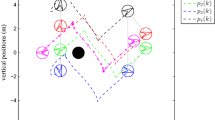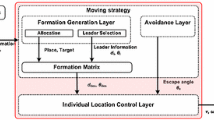Abstract
This paper considers the problems of formation and obstacle avoidance for multiagent systems. The objective is to design a term of agents that can reach a desired formation while avoiding collision with obstacles. To reduce the amount of information interaction between agents and target, we adopt the leader-follower formation strategy. By using the receding horizon control (RHC), an optimal problem is formulated in terms of cost minimization under constraints. Information on obstacles is incorporated online as sensed in a limited sensing range. The communication requirements between agents are that the followers should obtain the previous optimal control trajectory of the leader to each update time. The stability is guaranteed by adding a terminal-state penalty to the cost function and a terminal-state region to optimal problem. Finally, simulation studies are provided to verify the effectiveness of the proposed approach.
Similar content being viewed by others
References
B. Liu, T. Chu, L. Wang, et al. Collective motion of a class of social foraging swarms[J]. Chaos, Solitons and Fractals, 2008, 38(1): 277–292.
F. Xiao, L. Wang, J. Chen, et al. Finite-time formation control for multi-agent systems[J]. Automatica, 2009, 45(11): 2605–2611.
Z. Lin, M. Broucke, B. Francis. Local control strategies for groups of mobile autonomous agents[J]. IEEE Transactions on Automatic Control, 2004, 49(4): 622–629.
O. Khatib. Real-time obstacle avoidance for manipulators and mobile robots[J]. Journal of Robotics Research, 1986, 5(1): 90–98.
G. V. Raffo, G. K. Gomes, J. E. Normey-Rico, et al. A predictive controller for autonomous vehicle path tracking[J]. IEEE Transactions on Intelligent Transportation system, 2009, 10(1): 92–102.
W. B. Dunbar, R. M. Murray. Model predictive control of coordinated multi-vehicle formations[C]//Proceedings of the 41st IEEE Conference on Decision and Control. New York: IEEE, 2002: 4631–4636.
R. Olfati-Saber, W. B. Dunbar, R. M. Murray. Cooperative control of multi-vehicle systems using cost graphs and optimization[C]// Proceedings of the American Control Conference. New York: IEEE, 2003: 2217–2222.
W. B. Dunbar, R. M. Murray. Distributed receding horizon control for multi-vehicle formation stabilization[J]. Automatica, 2006, 42(4):549–558.
T. Keviczky, F. Borrelli, K. Fregene. Decentralized receding horizon control and coordination of autonomous vehicle formations[J]. IEEE Transactions on Intelligent Transportation System, 2008, 16(1): 19–33.
I. D. Couzin, J. Krause, N. R. Franks, et al. Effective leadership and decision-making in animal groups on the move[J]. Nature, 2005, 433(7025): 513–516.
B. Liu, T. Chu, L. Wang, et al. Controllability of a leader-follower dynamic network with switching topology[J]. IEEE Transactions on Automatic Control, 2008, 53(4): 1009–1013.
L. Huang. Velocity planning for a mobile agent to track a moving target-a potential field approach[J]. Robotics and Autonomous Systems, 2009, 57(1): 55–63.
J. Choi, S. Oh, R. Horowitz. Distributed learning and cooperative control for multi-agent systems[J]. Automatica, 2009, 45(12): 2802–2814.
T. Yang, Z. Liu, H. Chen. Formation control and obstacle avoidance for multiple robots[J]. Acta Automatica Sinica, 2008, 34(5): 588–593.
M. Defoort, A. Kokosy, T. Floquet, et al. Motion planning for cooperative unicycle-type mobile robots with limited sensing ranges: A distributed receding horizon approach[J]. Robotics and Autonomous Systems, 2009, 57(11): 1094–1106.
R. Olfati-Saber. Flocking for multi-agent dynamic systems: Algorithms and theory[J]. IEEE Transactions on Automatic Control, 2006, 51(3): 401–420.
D. Gu, H. Hu. A stabilizing receding horizon regulator for nonholonomic mobile robots[J]. IEEE Transactions on Robotics, 2005, 21(5): 1022–1028.
W. B. Dunbar. Distributed Receding Horizon Control for Multiagent Systems[D/OL]. Pasadena, CA: California Institute of Technology, 2004: http://thesis.library.caltech.edu/2198/.
Author information
Authors and Affiliations
Corresponding author
Additional information
This work was supported by the National Basic Research Program of China (973 Program) (No. 2010CB731800), the Key Program of National Natural Science Foundation of China (No. 60934003), the National Natural Science Foundation of China (No. 61074065, 60974018), the Key Project for Natural Science Research of Hebei Education Department (No. ZD200908), and Key Project for Shanghai Committee of Science and Technology (No. 08511501600).
Jing YAN received his B.E. degree in Automation from Henan University, China, in 2008. He is currently working toward the Ph.D. degree in Control Theory and Control Engineering at Yanshan University, China. His research interests include cooperative control of multiagent systems, and wireless networks.
XinPing GUAN received his M. S. degree in Applied Mathematics in 1991, and Ph.D. degree in Electrical Engineering in 1999, both from Harbin Institute of Technology, China. Since 1986, he has been at Yanshan University, China, where he is currently a professor of Control Theory and Control Engineering. In 2007, he also joined Shanghai Jiao Tong University, China. His research interests include robust congestion control in communication networks, cooperative control of multiagent systems, and networked control systems.
Xiaoyuan LUO received his Ph.D. degree from the Department of Electrical Engineering, Yanshan University, China, in 2005. He is currently an associate professor in Yanshan University. His research interests include multiagent systems, and networked control systems.
Fuxiao TAN received his Ph.D. degree in Control Theory and Control Engineering from Yanshan University, in 2009. He is currently an associate professor in Fuyang Teachers College, China. His research interests include cooperative control of multiagent systems, and networked control systems. Email
Rights and permissions
About this article
Cite this article
Yan, J., Guan, X., Luo, X. et al. Formation and obstacle avoidance control for multiagent systems. J. Control Theory Appl. 9, 141–147 (2011). https://doi.org/10.1007/s11768-011-9174-7
Received:
Revised:
Published:
Issue Date:
DOI: https://doi.org/10.1007/s11768-011-9174-7




